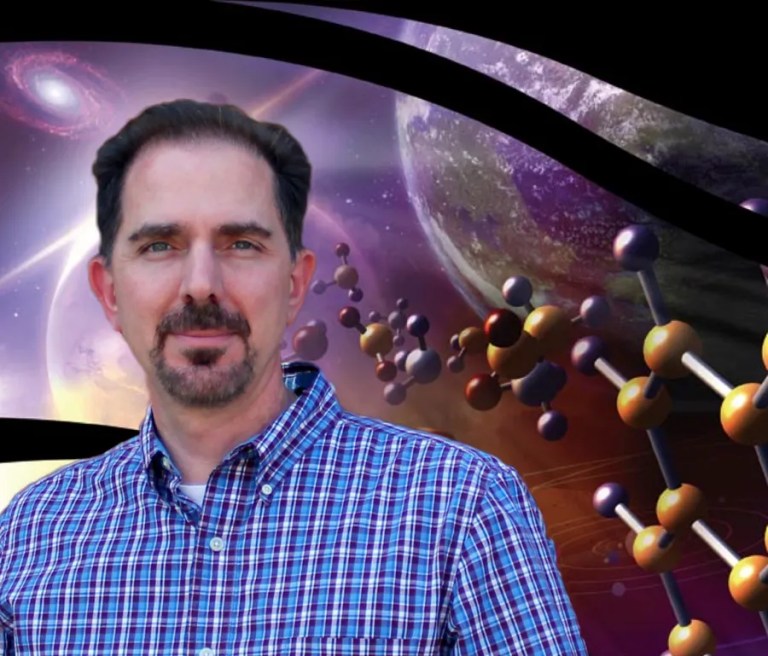
Andrew Mattioda
Research Scientist
Email: Andrew.Mattioda@nasa.gov
Phone: (650)604-1075
Read Andy Mattioda‘s interview
Professional Biography
Dr. Mattioda is a research scientist in the Astrochemistry and Astrophysics Laboratory at the NASA Ames Research Center, where he leads the ICEE (Instrument for Carbon Evolution Experiments) research group. He grew up in the town of Hartshorne, Oklahoma working on the family farm and at the family’s full-service gas station, where he was always taking things apart, seeing how they worked. After graduating from Hartshorne High School, Dr. Mattioda started his college career earning degrees from Eastern Oklahoma State College, East Central University and the University of Oklahoma. His graduate research focused on material science, understanding the relationship between a substance’s molecular structure and its physical properties. In a certain sense, Dr. Mattioda was still taking things apart to see how they worked, but this time on a molecular level. After finishing his Ph.D., Dr. Mattioda worked for the U.S. Army Corps of Engineers performing environmental site investigations of former and current military installations. Dr. Mattioda joined NASA Ames’ Astrochemistry and Astrophysics Laboratory, in 2000, to study the infrared spectra of neutral and ionized polycyclic aromatic hydrocarbons or PAHs and compare them to infrared astronomical observations (ground-based, airborne, and spaceborne). This work has been incorporated into the groups PAH IR Spectral Database, which Dr. Mattioda helped establish. Since joining the Astrochemistry Laboratory group, Dr. Mattioda has expanded his research to include the processing of PAHs and other organic molecules by various radiation sources (UV photons, electrons and protons), both with and without the presence of water ice to help interpret data from NASA missions such as Cassini and the James Webb Space Telescope (JWST). His research also includes studying the role of dust grain surfaces in extraterrestrial organic chemistry. Dr. Mattioda served as the instrument scientist, responsible for processing and interpreting the data, for SEVO (Space Environment Viability of Organics) onboard the O/OREOS (Organisms/ORganics Exposure to Orbital Stresses) cubesat. His laboratory performed the ground control experiments for the SEVO mission. Dr. Mattioda has also been involved in various experimental missions aboard the International Space Station (ISS) aimed at understanding how molecules are processed by radiation in space. Currently, he is serving as a senior scientist for the OREOCube and EXOCube platforms being developed by ESA (European Space Agency) as experimental facilities for the ISS to study space radiation impacts on biological molecules and microorganisms. Outside of the laboratory, Dr. Mattioda manages the STEM (Science, Technology, Engineering, and Mathematics) outreach efforts to the Choctaw and Chickasaw Nations for his team’s NASA Astrobiology Institute grant, helping to promote science and engineering careers to the Native American youth.
Education
A.S. with highest honors in Science, Eastern Oklahoma State College, Wilburton, OK 74578
B.S. with high honors in Chemistry and Mathematics, East Central University, Ada, OK, 74820
M.S. Physical Chemistry, University of Oklahoma, Norman, OK, 73019
Ph.D. Physical Chemistry, University of Oklahoma, Norman, OK 73019
Research Interests
Laboratory astrochemistry/astrophysics/astrobiology
Molecular spectroscopy (infrared and Raman)
The study of extraterrestrial chemistry (especially organic)
Surface Catalysis
Infrared Astronomy (PAH IR Spectral Database)
Extraterrestrial analysis (in-situ chemical investigations)
Select Publications
Infrared Spectroscopy of Matrix-Isolated Neutral and Ionized Anthracoronene in Argon, A.L.F. de Barros, A.L. Mattioda, J.M. Korsmeyter, A. Ricca, J.Phys. Chem. A. 122, pp 2361-2375 (2018).
Photochemistry of Coronene in Cosmic Water Ice Analgos at Different Concentrations, A.L. F. de Barros, A.L. Mattioda, A. Ricca, G. Cruz-Diaz, and L.J. Allamandola, Ap.J. 848,19pp (2017).
Infrared Spectroscopy of Matrix-Isolated Neutral Polycyclic Aromatic Nitrogen Heterocycles: The Acridine Series, Mattioda, A.L., Bauschlicher Jr., C.W., Ricca, A., Bregman, J., Hudgins, D.M., Allamandola, L.J., Spectrochimica Acta Part A, 181,286 (2017).
The anharmonic quartic force field infrared spectra of five non-linear polycyclic aromatic hydrocarbons: Benz[a]anthracene, chrysene, phenanthrene, pyrene, and triphenylene, Mackie, C.J., Candian, A., Huang, X., Maltseva, E., Petrignani, A., Oomens, J., Mattioda, A.L., Jan Buma, W., Lee, T.J., Tielens, A.G.G.M., J.Chem.Phys., 145, 084313 (2016).























